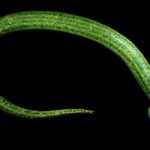Salamanders and Frogs Hide a Glowing Secret
Biofluorescent animals have been documented before, but most of them were aquatic. Scientists at the St. Cloud State University in Minnesota used blue light on 14 different families of amphibians and found that they all glowed in some way, each with different intensities and patterns. This was most likely developed by their ancestors, but the scientists still aren’t sure what it’s purpose might be. It could be used for communication or evading predators, but there are useful applications for humans as well. This natural biofluorescence can be useful for medical imaging and lead to important medical advances. It also makes these animals easier to find and survey in the wild for research and conservation purposes.
Learn about our two Decals!
 Click here to find out more about our Fall Bioinspired Design Decal and our Spring Bioinspired Design in Action Decal – ALL MAJORS are welcome.
Click here to find out more about our Fall Bioinspired Design Decal and our Spring Bioinspired Design in Action Decal – ALL MAJORS are welcome.Berkeley BioDesign Community
 Click here to learn about the BioD: Bio-Inspired Design @ Berkeley student organization or here to signup for more info.
Click here to learn about the BioD: Bio-Inspired Design @ Berkeley student organization or here to signup for more info.Search
Student Login





I imagine that the neurological circuits underlying these processes are governed by both 2d spacing maps with their brains as…
to reduce the impact of car accidents, it may be possible to study the force diverting physics of cockroaches to…
you see this type of head-bobbing stability in many avian creatures related to pigeons like chickens. the head ability to…
not like they taught horses how to run! this is an example of convergent evolution where both sea creatures and…
The brain functions in a similar way with neuronal connections. our brains are able to utilize the multiplicity of connections…